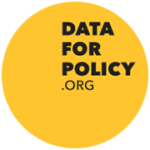April’25 Fireside Chat
Event Summary
On 28 April 2025, we hosted another engaging session of our monthly Fireside Chat series, Elena Wüllhorst (King’s College London) presented findings from her collaborative research with Dr Mona Sloane (University of Virginia), titled “A Systematic Review of Regulatory Strategies and Transparency Mandates in AI Regulations in Europe, the U.S. and Canada.” The session was chaired by Dr Zeynep Engin, Founding Director of Data for Policy CIC and Editor-in-Chief of the Data & Policy journal.
The discussion explored patterns in AI regulatory strategies and transparency mandates based on a comprehensive review of 129 AI-related regulations across Europe, the U.S., and Canada. Elena Wüllhorst presented key findings from their joint research paper —originally presented at the Data for Policy 2024 conference, highlighting the growing need to bridge the gap between AI policy discourse and applied research on transparency and compliance. The session addressed regional differences in regulatory activity, emerging trends in local AI laws, and the challenges of global harmonisation. Questions from participants centred around definitional ambiguities, sector-specific strategies, and the evolving scope of transparency in AI governance.
Discussion Highlights
The session introduced three primary regulatory strategies found in the dataset:
- Overhauls of existing legal frameworks to address AI risks (42%)
- Novel AI Regulations targeting specific technologies or use cases (50%)
- Omnibus Regulations with broader, cross-sector mandates (8%)
Examples included U.S. state-level amendments to anti-discrimination laws and the EU AI Act’s comprehensive risk-based approach. Local and state-level actions especially in the U.S., were noted for their faster adoption cycles and clear operational guidelines.
Transparency Mandates: Patterns and Challenges: The analysis identified six distinct types of transparency mandates:
- Assessments (e.g. risk or impact evaluations)
- Disclosures (e.g. notifying users of AI use)
- Audits (evaluating AI performance)
- Inventories (cataloguing AI systems and training data)
- Human-in-the-loop mechanisms
- Red teaming (stress-testing AI systems)
Findings revealed that assessments and disclosures were the most common mandates, often used in combination. However, 48 out of 129 regulations included no transparency requirement at all, highlighting an uneven regulatory landscape.
Definitional Ambiguities: What Is AI? What Is Transparency? Participants discussed the lack of consistent definitions across jurisdictions, particularly for “AI” and “transparency”. This ambiguity impacts regulatory clarity and enforcement. The conversation explored how overlapping or circular definitions create challenges for compliance, and how local regulations sometimes offer clearer, more actionable language than national or transnational frameworks.
Coping with Technological Change: Ms Wüllhorst addressed the regulatory lag caused by the fast pace of AI innovation. While omnibus regulations like the EU AI Act take years to develop, novel or adaptive strategies at the local level offer faster, more targeted responses. Participants highlighted the importance of multilevel governance and bottom-up policy approaches to adapt to emerging technologies like generative AI.
Sector-Specific Applications and Gaps: Several participants raised questions about sector-specific patterns, noting that many novel AI regulations are targeted at areas such as hiring, insurance, or facial recognition. Local-level laws often share similar language and regulatory approaches. However, participants also noted significant geographic and sectoral gaps, particularly the lack of data from non-Western countries.
Global Perspectives and Future Work: The session concluded with a call to expand the scope of regulatory analysis beyond North America and Europe. Participants agreed on the need for a more comprehensive, global dataset to reflect diverse legal traditions, technological priorities, and societal values. Plans were shared to update and expand the research, incorporating new regulations and exploring alternative governance models.
We look forward to the next session in our Fireside Chat series, where we will continue to explore critical issues shaping the future of data governance, AI regulation, and policy innovation.
